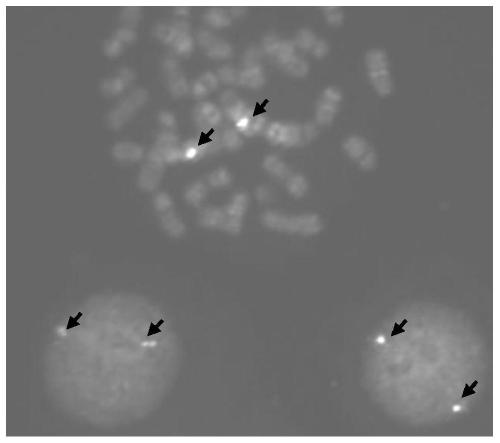Probe group and kit used to detect HER-2 gene proliferation level and application thereof
A HER-2 and gene amplification technology, which is applied in recombinant DNA technology, microbial measurement/inspection, DNA/RNA fragments, etc., can solve problems such as time-consuming, difficult to evaluate false-negative results, and patients' missed opportunities for medication, etc., to achieve Accurate diagnosis and treatment, rapid hybridization effect
- Summary
- Abstract
- Description
- Claims
- Application Information
AI Technical Summary
Problems solved by technology
Method used
Image
Examples
preparation example Construction
[0023] In some embodiments, the present invention provides a method for preparing the above-mentioned probe, comprising: probe labeling (using phi29 DNA polymerase labeling )→Quantitative (#The sample volume and length of the probe will affect the hybridization effect)→Packing / stand-by.
[0024] In some embodiments, the present invention provides the optimization process of the probe hybridization system, which mainly involves the selection of hybridization promoters, and reduces the hybridization time to achieve rapid hybridization. The specific optimization process is as follows:
[0025] (1) Accelerator selection:
[0026] During the hybridization process, increasing the denaturant can affect the base stacking force and the formation of hydrogen bonds, increase the hydrophobicity of water and reduce the energy difference between double-stranded and single-stranded DNA, and reduce the Tm value. The current conventional hybridization buffer contains formamide, and the hy...
Embodiment 1
[0035] Embodiment 1 probe design and preparation
[0036] An embodiment of the probe set for detecting the amplification level of HER-2 gene of the present invention includes 3 probes, respectively targeting 3 sequence segments on the human genome, namely HER-2, RAI1 and 17 Centromere region of chromosome number.
[0037] 1) The probe design process includes:
[0038] BAC clone selection → purchase (commercialization) → labeling, testing → confirmation of the probe clone group (available for subsequent production).
[0039] For the method of BAC clone screening, please refer to p26-28 of Zhao Jia et al.
[0040] • BAC clone selection (see Table 2): Gene site probes are generally designed to detect probes that include the gene. Probe clone selection should pay attention to the specificity of clones, and select clones whose fluorescence intensity meets the requirements to prepare probes through verification. In order to ensure the brightness of the signal, the length of the ...
Embodiment 2
[0054] Embodiment 2 probe hybridization system
[0055] The labeled probes of Example 1 were prepared in the hybridization system as shown in Table 4:
[0056] Table 4 hybrid system
[0057] ingredients per test Green probe (50ng / μl) 0.3~0.6μl Red probe (50ng / μl) 0.3~0.5μl Cyan probe (50ng / μl) 0.2~0.4μl hybridization buffer 7μl COT Human DNA (1mg / ml)* 1μl h 2 o
[0058] *COT Human DNA is placental DNA, mainly 50 to 300bp in length, and rich in repetitive DNA sequences, such as Alu and Kpn family members, usually used to block non-specific hybridization and suppress repetitive DNA sequences.
PUM
| Property | Measurement | Unit |
|---|---|---|
| Sensitivity | aaaaa | aaaaa |
Abstract
Description
Claims
Application Information
 Login to View More
Login to View More - R&D
- Intellectual Property
- Life Sciences
- Materials
- Tech Scout
- Unparalleled Data Quality
- Higher Quality Content
- 60% Fewer Hallucinations
Browse by: Latest US Patents, China's latest patents, Technical Efficacy Thesaurus, Application Domain, Technology Topic, Popular Technical Reports.
© 2025 PatSnap. All rights reserved.Legal|Privacy policy|Modern Slavery Act Transparency Statement|Sitemap|About US| Contact US: help@patsnap.com



